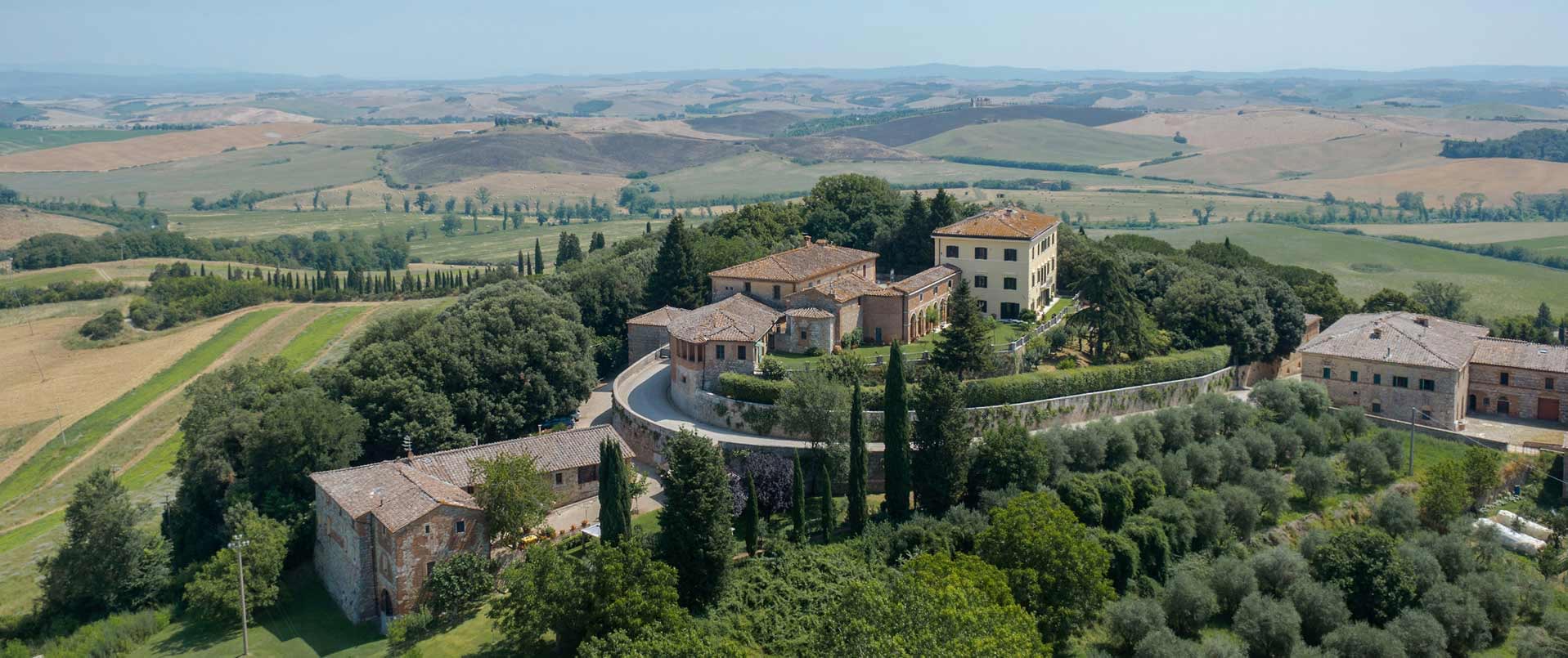
Borgo Riccio, overlooked by the 12th-century fortress church of SS. Salvatore, stands on the edge of the historic centre of Torchiara, a medieval village just a few kilometres from Paestum and the Blue Flag beach of Agropoli, in the province of Salerno.
Immersed in a park of about three hectares characterised by Mediterranean vegetation and typical local crops such as olive trees, fruit trees and white figs, Borgo Riccio is an enchanting oasis of peace where it is possible to savour the ‘slow holiday’ experience of the relaxed style of Cilento culture.
Staying at Borgo Riccio allows you to enjoy firsthand the Italian tradition of hospitality and, with the guidance of the owners, discover the roots of Mediterranean culture. Formerly owned by the Riccio family of Torchiara, the property was restored and renovated in the 1990s. Borgo Riccio is spread over multiple levels connected by stone and brick staircases typical of the area, blending seamlessly with nature and the surrounding buildings.
The complex is composed of two houses and three dovecotes: the lower one, along what is now the provincial road, offers a living room, four rooms with private bathrooms, a stone table under the flowering pergola and a meditation area in the shade of a large olive tree.
Ascending the external steps amidst vases of agave plants and flowers, one reaches a terrace with a wood-fired oven, leading to the Salone Milano, which has a stirring view of the surrounding nature through its large windows. Equipped with advanced projection equipment and Wi-Fi, and furnished with design elements, such as the C.R. Mackintosh willow throne armchair, the Zanuso table, the Magistretti chest of drawers and Artemide lights, Salone Milano is the ideal place to hold your business meetings and high-level conferences. Resuming the steps, one then arrives at the swimming pool and the upper house with its open-air lounges, leading to the palm tree square from which you can ascend towards the village along the palm-lined avenue. The upper house is like a kind of belvedere, allowing your gaze to sweep across the whole valley and beyond towards the sea. The ground floor is accessed through the ancient portals, where the living room feature a large Neapolitan nativity scene. There is a dining room with old stone fireplaces, a study, and on the upper floor, three more bedrooms with private bathrooms.
Descending from the upper house via another set of steps amidst olive trees, you reach the library, the tower room with its private bathroom, and the wellness area where there is a gym, a hydromassage whirlpool and a sauna available for guests’ use. The interior spaces are steeped in ancient traditions and cultural heritage, with antique items of family furniture displayed alongside pieces brought back from the owner’s extensive world travels.
The history of Borgo Riccio
A mediaeval town with an ancient history, Torchiara has followed the changing fortunes of the Cilento Barony, eventually becoming in the 19th century the administrative capital of the Vallo district, a role it retained even after the Unification of Italy. This explains the proliferation of many important Palazzos that can still be seen today in the historical centre: more than 14 buildings are connected by a Greenway itinerary that can be walked or cycled. However, Torchiara was also, and above all, a town of revolutionaries: it was from here that the uprisings started firstly in 1828 and then in 1848, led by the Pavone brothers and Giambattista Riccio, a martyr of the war involved in the Unification of Italy and an ancestor of Angela Riccio de Braud, the current owner of Borgo Riccio.
Andrea Torre used to come to converse with his childhood friend Andrea Riccio, who was the owner’s grandfather, in the old ‘casino’, which is now the lounge of Borgo Riccio. The former Andrea later became a Senator of the Kingdom of Italy and a member of Accademia dei Lincei scientific institution. He founded the “Il Mondo” newspaper and was a director at “La Stampa.” While the complete history of Borgo Riccio has been partially lost, testified only by its ancient 19th-century portals, fireplaces, and recollections passed down by word of mouth, it now lives on with a whole new vision as a site that encourages the recovery, valorisation and promotion of the unique cultural values of Cilento. Angela Riccio de Braud has indeed become a recognized spokesperson for this cause. After dedicating herself to the restoration of the hamlet with her life-long experience, employing traditional local construction techniques, such as Cilento plaster for the exteriors, hand- forged wrought iron from local blacksmiths, handcrafted terracotta floors, and ancient ceiling beams, she is now committed to projects aimed at showcasing the traditions of Cilento.
Angela Riccio de Braud, an architect by profession, who has always lived between Milan and Rome, dedicated herself for twelve years to ecology, writing about these topics for “Il Sole 24 Ore” and serving as the director of the “Acqua e Aria” scientific journal of the National Research Council (CNR). After working for 16 years for the exhibition centre Fiera Milano as the central Director of Communications and then for four years at the public broadcasting company RAI as an assistant to the director-general, Angela decided to return to her roots, where her family has deep connections, and organise projects aimed at making the world more aware of Cilento’s invaluable heritage. This is where the idea of opening Borgo Riccio to hospitality came from, offering tailored itineraries to discover the territory and its environmental, cultural and gastronomic heritage. A further development is her involvement in special projects, such as one for artists following the Grand Tour and the Story Riders cultural event that transforms Torchiara into the “land of stories” every year. In this way, the history of the ancient ‘casino’ continues today in the Borgo Riccio project, which has been attracting representatives from the economic, social, political, and cultural spheres for the past thirty years.
Facilities and services at Borgo Riccio
Angela Riccio de Braud and Alberto Zobbi welcome their guests to Borgo Riccio, offering hospitality services with a traditional Cilento breakfast served in the gardens or in the cosy dining room. The garden and the swimming pool are at the guests’ complete disposal, as is the free Wi-Fi internet connection available in the bedrooms and common areas.
A transfer service from Rome and Naples airports can be arranged upon request, as well as various tailor-made excursions and guided tours for Borgo Riccio’s guests.
Our small and welcoming Relaxation Area is available for exclusive use and is equipped with a sauna, a hot tub and a mini gym.
Borgo Riccio has a multifunctional space that can host conferences, corporate events, meetings or even bridge tournaments.
For small groups, cooking courses, wine tastings, and local product tastings can be organised.
Places of interest in the vicinity
The historical residence of Borgo Riccio is located in the heart of Cilento, close to extraordinary places such as Pompeii and Agropoli, a stone’s throw from the sea and immersed in greenery, surrounded by a garden featuring over 400 olive trees, some of which are centuries old, interspersed with white fig trees, flowers and Mediterranean vegetation. It is a enchanting place in the heart of the countryside of the characteristic village of Torchiara, in the province of Salerno, where the owner Angela Riccio de Braud has undertaken to revive one of the most beautiful historic residences in the area. The village has preserved its ancient appearance, with magnificent noble Palazzos and the 11th-century fortress church of San Salvatore.
Torchiara is however best known for its Greenway, a 12-kilometre green route that can be travelled on foot, by bicycle or on horseback, an itinerary that enables visitors to discover the town’s architectural and landscape beauties. Located in a hilly area in the Cilento and Vallo di Diano National Park, a UNESCO World Heritage Site, Borgo Riccio’s bed and breakfast property has the stunning sea of Agropoli behind it, an ancient Saracen village that is now a charming town, recognised with the Blue Flag award for its transparent waters. Unforgettable bathing experiences can be experienced at Vallone and Punta Tresino, a marine nature reserve just 10 minutes away from Borgo Riccio.
Not far away are the archaeological sites of Paestum, Velia and Pompeii, as well as the steep, rugged coastline of Palinuro, the long beach with a pine forest that reaches the sea at Punta Licosa, and the villages and towns of Amalfi and Positano.
 Accommodation
Accommodation
 Co-Working
Co-Working
 Film sets
Film sets
 Gardens
Gardens
 Parks
Parks
 Private events
Private events
 Residences
Residences
 Visits
Visits
 Weddings
Weddings
 Cooking courses
Cooking courses  Cultural tourism
Cultural tourism  Cyclotourism
Cyclotourism  Excursions
Excursions  Farmhouses
Farmhouses  Gardens
Gardens  Hiking
Hiking  Historic Homes open to visitors
Historic Homes open to visitors  Nature
Nature  Restaurants
Restaurants  Sports
Sports  Tasting
Tasting  Walking itineraries
Walking itineraries  Wine tourism
Wine tourism